
ALL YOU NEED TO KNOW - 2025 EMILIA-ROMAGNA GRAND PRIX
Table of Contents
Imola's Engineering Equation: 19 Turns, Counter-Clockwise Layout, Major Elevation Shifts, Longest Pit Lane, Highest Fuel Consumption Of 2024, Strategic Gravel Traps, The C6 Tyre Debut, And More...
The Autodromo Internazionale Enzo e Dino Ferrari, the historic circuit more commonly known as Imola, is set to host the Emilia Romagna Grand Prix. This event marks the start of the European leg of the championship. Nestled within Italy's renowned "Motor Valley," Imola offers a formidable and undiluted examination of both driver skill and car performance, demanding unwavering precision and a deep understanding of its unique, old-school character.
Circuit Characteristics and Challenges
This is a 4.909-kilometre (3.050 miles) circuit run in an anti-clockwise direction, which places it among a minority of global racetracks and imposes particular physical demands on drivers' necks due to the altered G-force loading. It is an unapologetically old-school venue: relatively narrow, lined with high and aggressive kerbs, and its character is forged by 19 corners – ten to the left and nine to the right – that meander through the picturesque Santerno River valley.
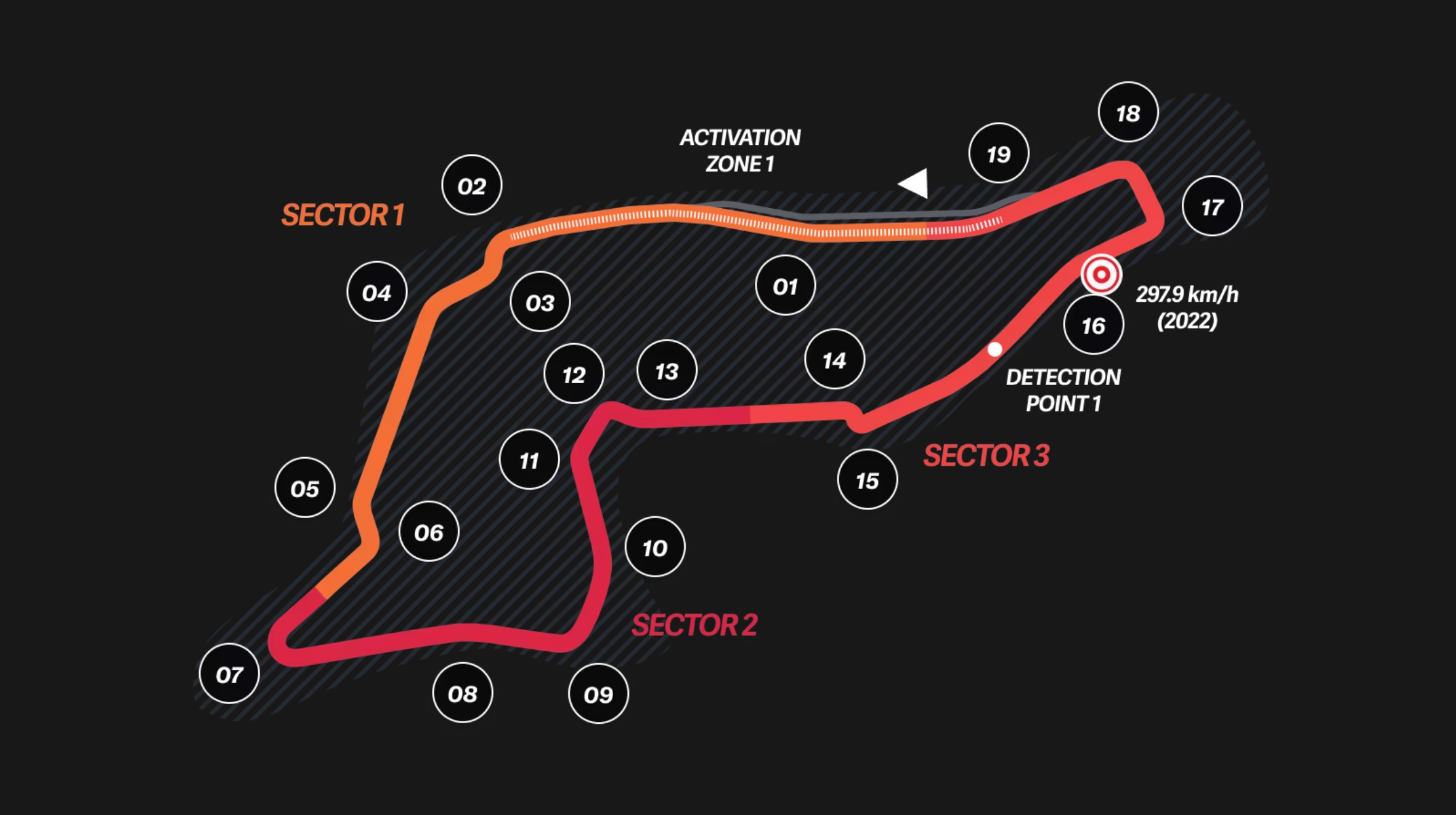
Dating back to the early 1950s, the track largely retains the architectural philosophy of that era. It makes good use of natural contours, with the tarmac ribbon climbing and descending the hillside, flashing past the terracotta-roofed houses and cypress trees that define its boundaries. Crucially, it wasn't designed with the dimensions and aerodynamic sensitivities of modern F1 cars in mind. This adds to what is often a tough, cagey race where maintaining track position can be more decisive than outright pace. The circuit's inherent tightness and relatively short length amplify the sensation of speed over a lap, further compounded by frequent gradient changes. Draped across the hillsides on the south bank of the Santerno River, the track is a slender ribbon packed between parks and residential zones, meaning run-off areas are at a premium and driver errors are often severely punished.
Modifications were made for the 2024 season, with the introduction of gravel traps at Turn 9 (Piratella), and at the exits of Turns 11, 12, and 13 (the Acque Minerali complex), as well as Turns 14 and 15 (Variante Alta). These changes were particularly significant at the exit of Turn 7 (Piratella), on the outside of Turns 11 and 12 (Acque Minerali), and on the exit of Variante Alta. Consequently, mistakes in these specific areas now carry a high probability of leading to retirement from the race.
For the 2025 event, more adjustments have been made concerning track limits. The white and blue lines that delineate these boundaries have been revised in almost every corner. While this should streamline the process for Race Control to monitor infringements, the stricter limits will undoubtedly make it tougher for drivers to keep all four wheels within the designated track surface.
At the start of the current ground-effect aerodynamic era, Imola presented a complex setup compromise. These cars typically perform optimally when run as low and stiff as possible. However, lap time at Imola was often found by softening the car's suspension to allow aggressive use of the kerbs at the various chicanes. This particular challenge has been somewhat mitigated, as Imola, in response to numerous track limits infringements, has installed new, less forgiving kerbs designed to compel cars to remain on the circuit. Despite this, the cars must still contend with some fairly significant bumps across the track surface, making suspension a major factor that frequently requires fine-tuning throughout the practice sessions.
TRACK CHARACTERISTICS
TRACTION
2/5
TYRE STRESS
3/5
ASPHALT GRIP
2/5
BRAKING
3/5
ASPHALT ABRASION
2/5
LATERAL
3/5
TRACK EVOLUTION
2/5
DOWNFORCE
3/5
Sectors and Key Corners: A Lap of Imola
A lap of Imola is a relentless sequence of iconic turns, each presenting its own distinct challenge and contributing to the circuit's formidable reputation.
Sector 1: High-Speed Entry and Early Challenges
The lap begins with a quick blast from the start-finish line towards the first chicane complex, Tamburello (Turns 2-3-4). This sequence of high-speed chicanes also represents the track’s only truly gilt-edged overtaking opportunity under braking at the end of the pit straight. From Tamburello, drivers thread their way down to the rapid flick through the Variante Villeneuve (Turns 5-6). This is immediately followed by the heavy braking zone for Tosa (Turn 7), a sharp left-hander where achieving good traction on exit is vital for the subsequent steep climb up the incline towards Piratella, which marks the transition into the second sector.
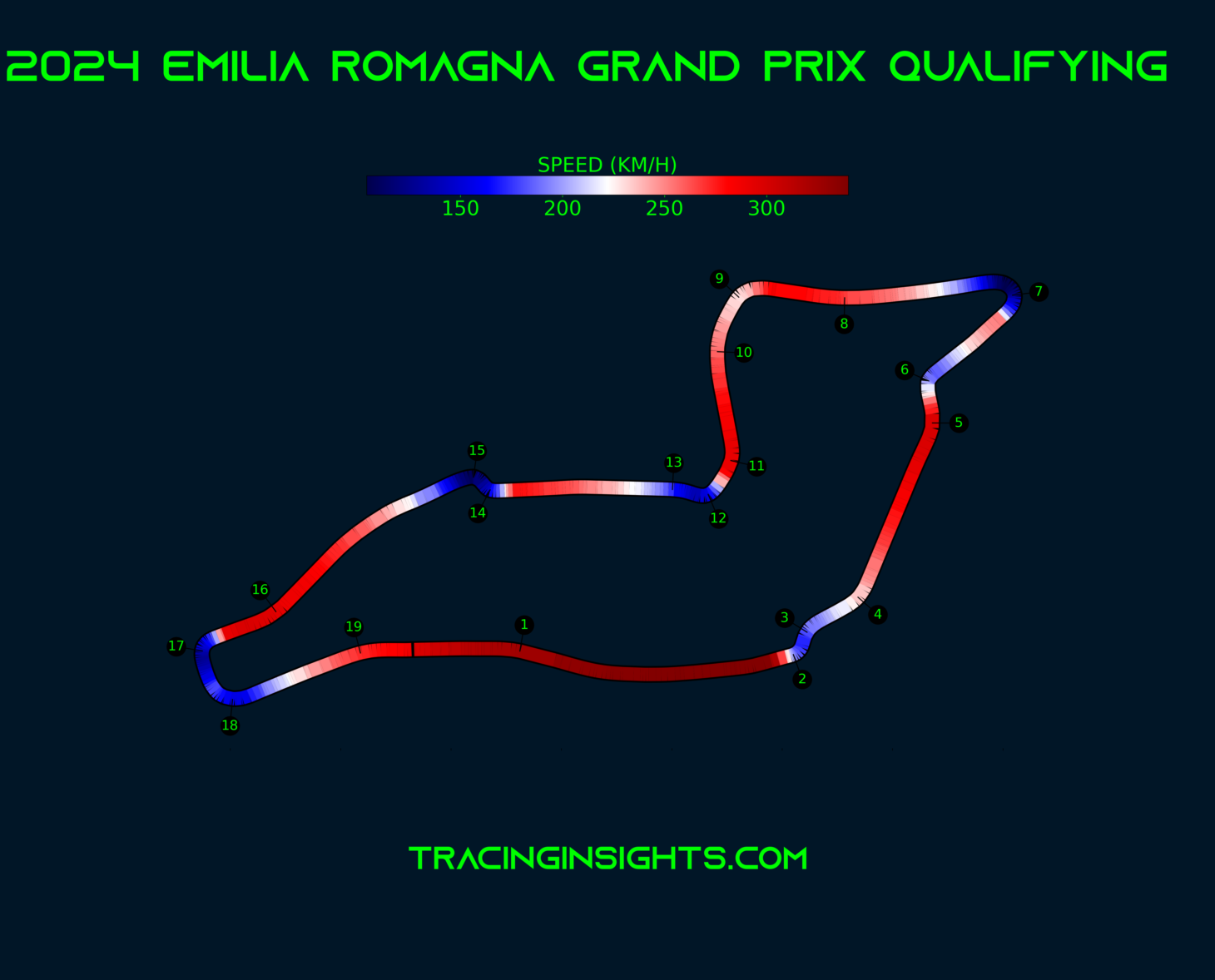
Sector 2: The Rollercoaster and Technical Tests
Sector 2 begins with the demanding, high-speed, blind-entry left-hander of Piratella (Turn 9), situated at the crest of a hill. From here, the track dramatically drops downhill through the rapid Acque Minerali complex (Turns 11-12-13). This section is one of the most technical and visually spectacular on the circuit, featuring a challenging downhill braking zone into a sequence of corners that test car balance and driver commitment. The sector concludes with the run up to the Variante Alta.
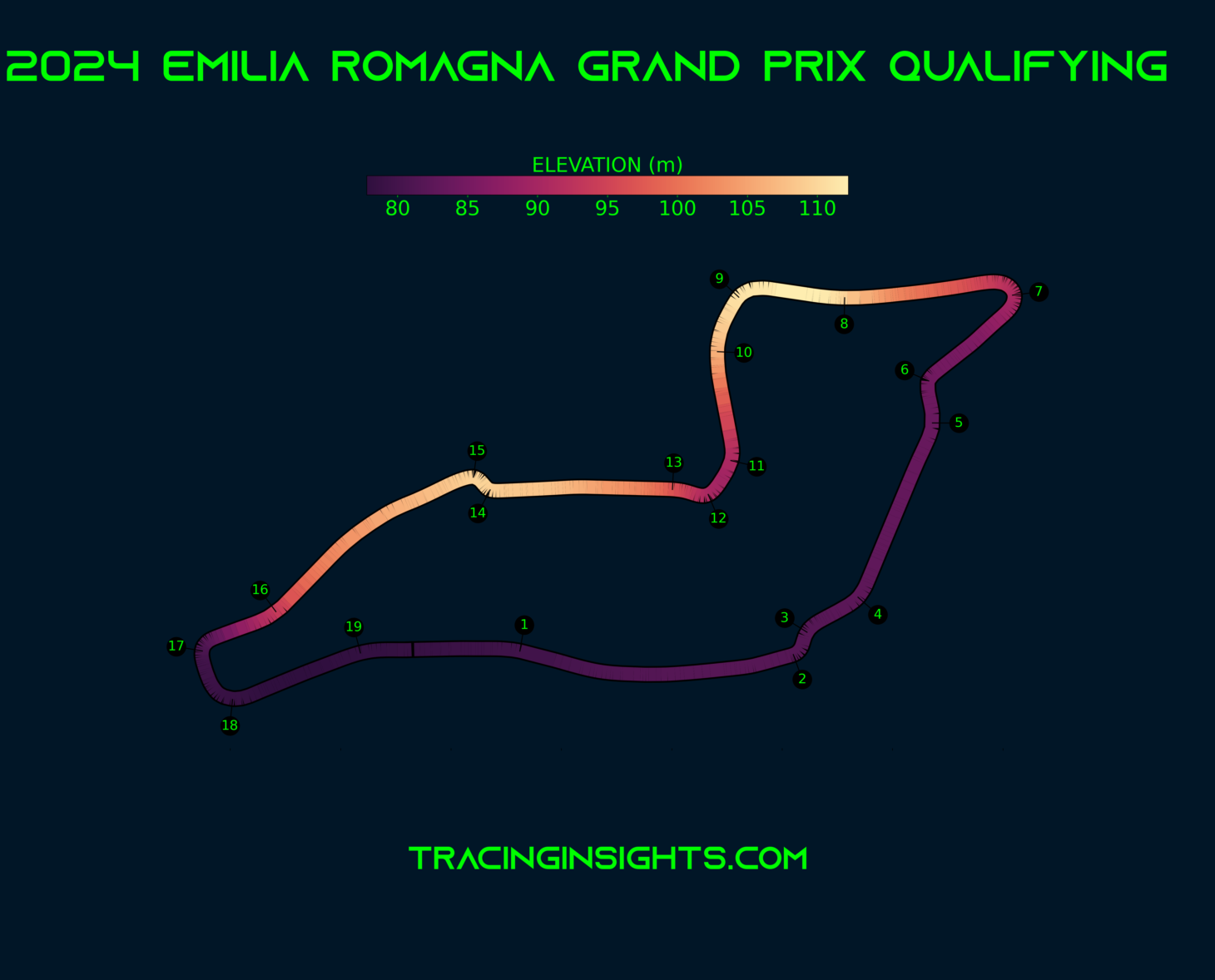
Sector 3: Hilltop Chicane and Final Dash
The third sector commences with the Variante Alta (Turns 14-15), a tight hilltop chicane that significantly breaks the circuit's flow before the descent towards the final corners. Following this is a tricky downhill run into the two right-hand Rivazza corners (Turns 17-18). From an anti-clockwise driver's perspective, these are experienced as a double left-hander. Exiting Rivazza, drivers accelerate onto the main straight, passing the pit entry and utilizing the circuit’s only DRS zone as they complete the historic lap.
The Imola layout rewards pinpoint precision, exceptional car stability, and a well-balanced chassis capable of handling the diverse range of corner types and elevation changes.
Pit Lane and Technical Features:
-
Pit Lane Time Loss: At 548 metres, the distance spent under the pit lane speed limit at Imola is the longest on the calendar. This contributes to a heavy pit-loss of 28.2 seconds.
-
Fuel Consumption: The race also has the highest level of fuel consumption seen on the 2024 calendar.
Racing Considerations:
The unique layout of Imola forces teams to make engineering and driving compromises.
Aerodynamic Setup Compromises:
Car setup, particularly concerning downforce levels, is largely dictated by the requirements for attacking and defending into the Tamburello chicane (Turns 2, 3, and 4). A medium downforce configuration is a common starting point for most teams. However, within this general approach, a critical choice emerges:
-
Opt for slightly less wing than the theoretical optimum. This helps with straight-line speed, improving opportunities for attack and defence at the end of the main straight's DRS zone.
-
Alternatively, run a little more wing. This aids traction and drive out of the final corner, Rivazza, giving a stronger launch onto the pit straight.
Tyre Management and Mechanical Stress:
Tyre degradation at Imola is affected by the frequent acceleration and braking zones. While the tyres are generally subjected to a low average load, leading to limited thermal degradation, other factors come into play. The circuit's aggressive, high kerbs transmit considerable mechanical stress through the car, particularly stressing the suspension components and the tyres themselves.
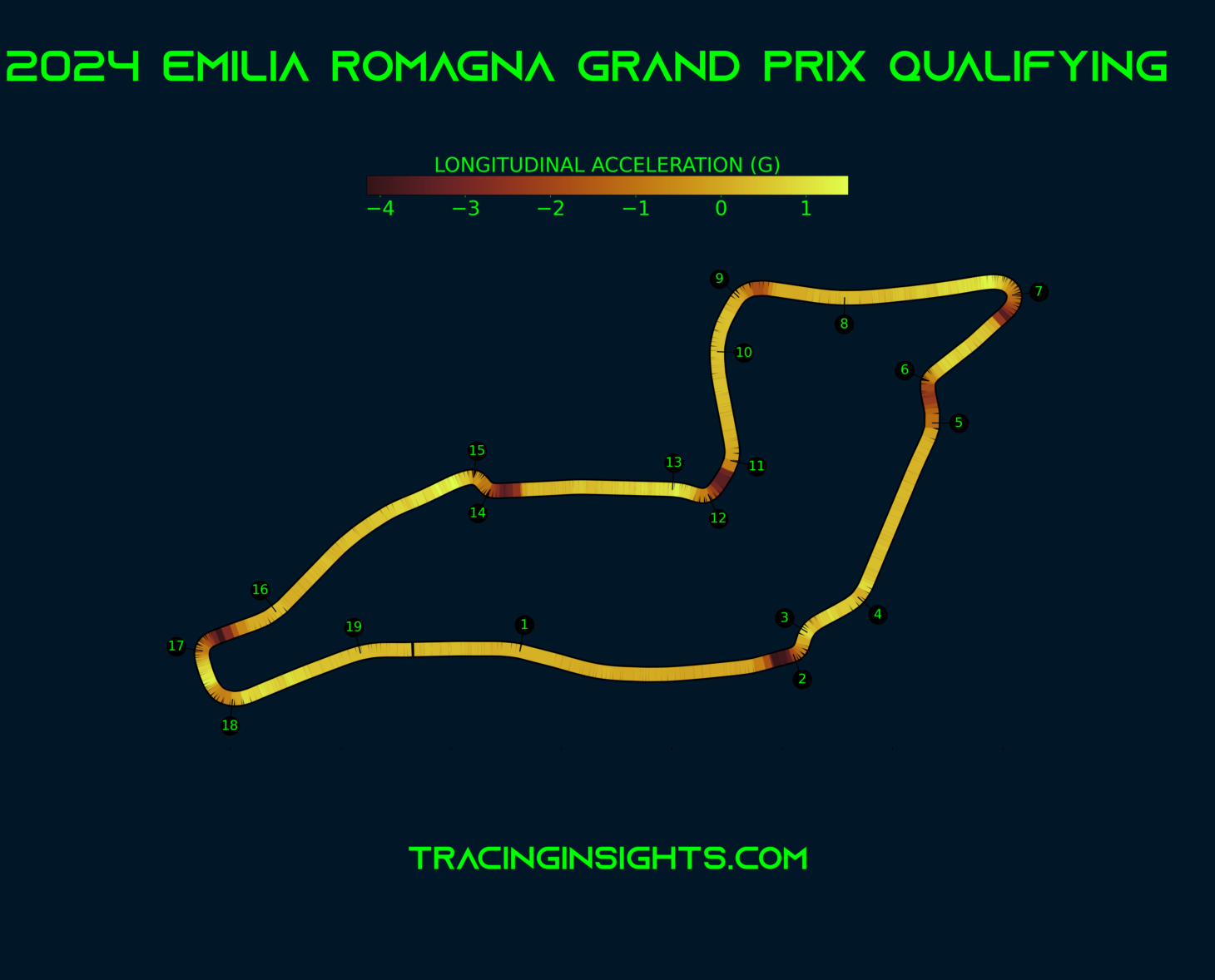
Overtaking Opportunities:
Overtaking at Imola is notoriously difficult. The circuit wasn’t designed for current cars to race side-by-side.
-
There is only one DRS zone, located on the pit straight. The detection point precedes the flat-out final corner. So, the only real overtaking opportunity comes at the end of this DRS zone, into the Tamburello chicane (Turns 2 and 3).
-
The limited opportunities for passing mean that achieving a good position on Saturday in qualifying is of high importance. Then, on Sunday, track position is king.
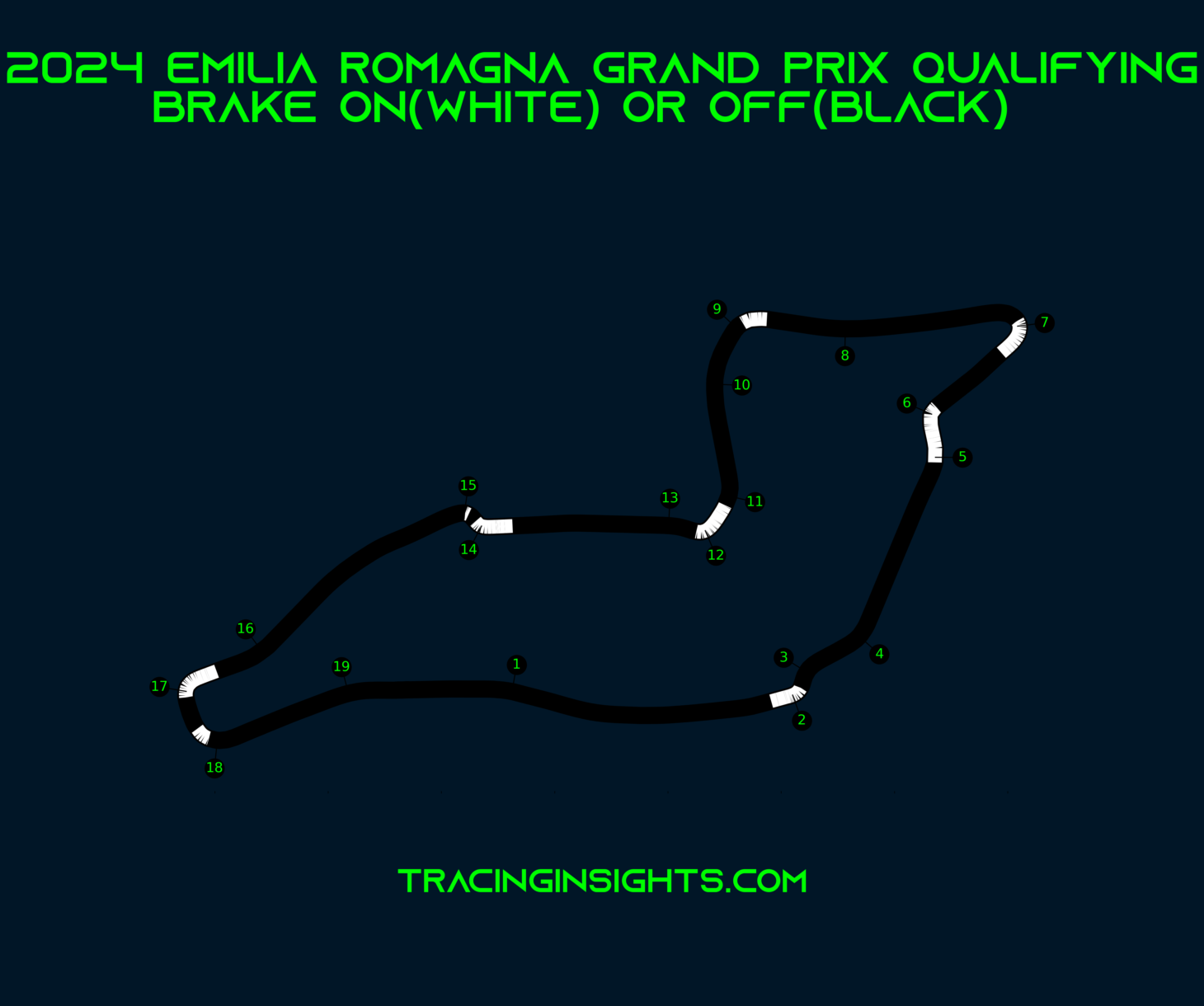
Tyre Selection and Strategy:
Pirelli has chosen the softest trio of compounds in its 2025 range. The C4 will be the Hard, the C5 the Medium, and the new C6 compound will make its race debut as the Soft.
-
C6 Compound Debut: This will be the first time that drivers will run the C6 on the 2025 season’s cars, as none of them used it in the Bahrain pre-season test. Homologated for use at tracks that stress the tyres the least, the C6 gives even more grip over a flying lap, especially as the Imola surface is less abrasive than average. It’s hard to imagine it being used for a race stint, but data gathered in Imola, and then from Monaco and Montreal, will allow the Pirelli engineers to evaluate it for other Grands Prix in the second part of the season. For the third race in a row, Pirelli has stepped down its range.
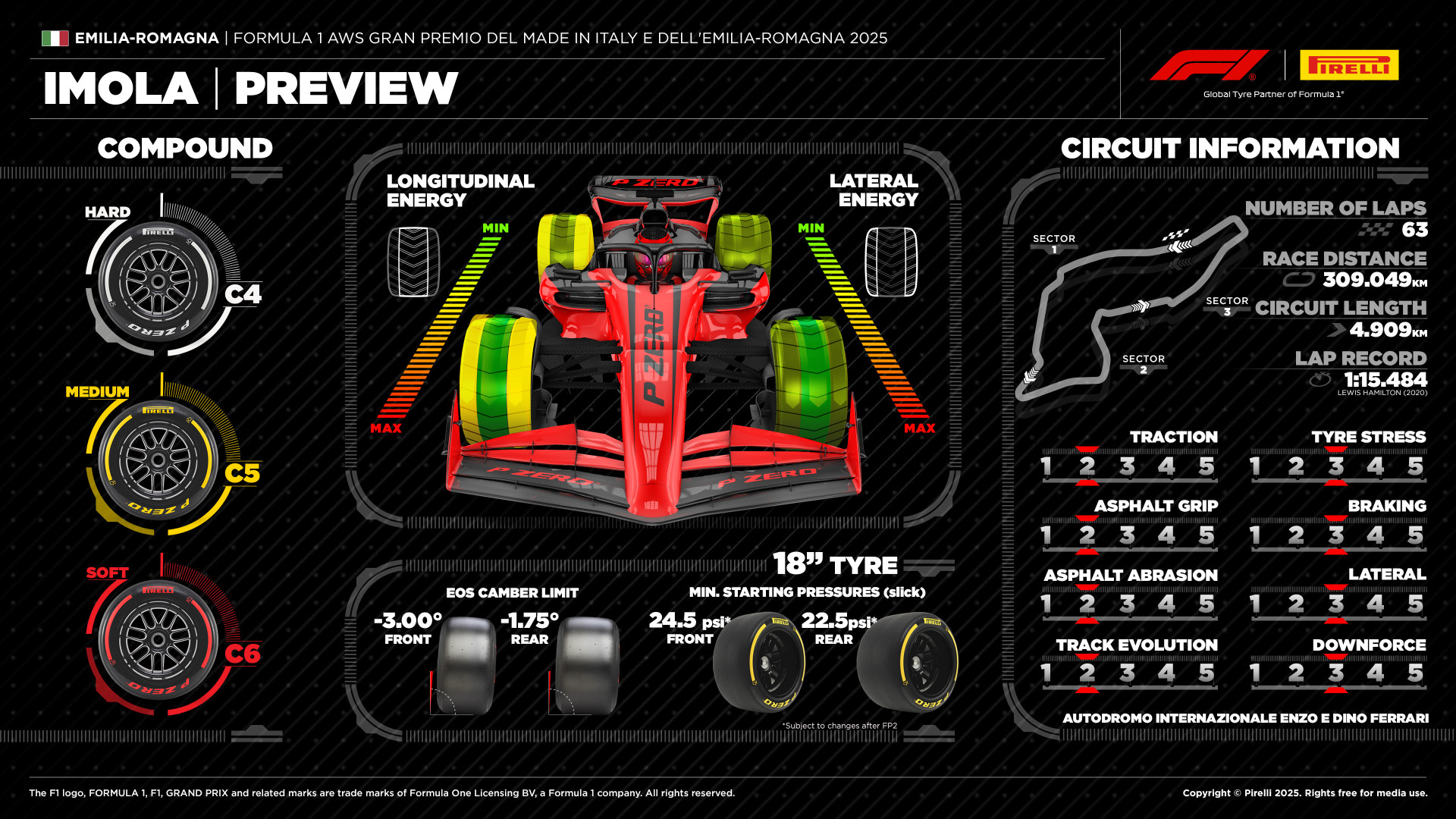
-
Race strategy at Imola is heavily influenced by circuit characteristics. Unlike Miami, where low degradation naturally leads to a one stop race as the quickest route, Imola brings different constraints. The extended pitlane length, coupled with the high speed run from the Rivazza corners, penalizes additional pit stops considerably. The circuit's narrow layout with just one DRS zone, and scarce overtaking spots make regaining track position after a stop a major hurdle.
Last Year's Strategic Picture
In 2024, the one-stop strategy proved the most competitive.
-
Starting Compounds: 15 drivers started the race on the Medium (C4), three on the Hard (C3), and two on the Soft (C5).
-
Compound Performance: The harder compounds worked best, offering very consistent performance with limited degradation, despite track temperatures above 50 °C. Those who started on the Soft had to make two stops. Fernando Alonso and Pierre Gasly opted to start on the C5 and both were forced into extra pit stops later on that in the end resulted in Pierre finishing 16th and Fernando 19th.
-
Winning Strategy: Max Verstappen won from pole by starting on medium tyres and then pitting for a set of new Hard tyres on lap 24.
-
Pit Window: The pit window was reasonably wide, with some cars stopping as early as lap eight, and Lance Stroll able to go all the way to lap 37 of the 63. The mainstream alternative was to try Hard-Medium, though given the grip given up at the start and the difficulty regaining places, that wasn’t particularly popular, with only Sergio Pérez scoring points with that approach.
-
The only other time there has been a fully dry race in the recent era was in 2020; on that occasion, when Pirelli provided C2-C4 tyres, Lewis Hamilton won with a two-stop strategy, starting on mediums and then cycling through the hard and soft. In the two wet races (2021 and 2022), Max Verstappen won with an inter, medium, medium strategy and an inter, medium, soft race strategy respectively.
Braking Demands
The Imola circuit features several corner sequences that alternate between requiring heavy braking and some flowing sections. The heavy braking zone into the Tosa corner (Turn 7) is a prime example. Tyre management is directly affected by the numerous acceleration and braking points around the lap. Turn 17, Turn 02 & Turn 14 are considered the most demanding for the braking system.
F1 BREMBO BRAKING DATA – IMOLA GP 2025
| Turn | Initial Speed (km/h) | Final Speed (km/h) | Stopping Distance (m) | Braking Time (sec) | Maximum Deceleration (g) | Maximum Pedal Load (kg) | Braking Power (kW) |
|---|---|---|---|---|---|---|---|
| ≡ 02 | 310 | 169 | 88 | 1.40 | 4.1 | 140 | 2,058 |
| = 06 | 274 | 208 | 43 | 0.67 | 4.0 | 142 | 1,809 |
| = 07 | 241 | 113 | 75 | 1.65 | 4.0 | 141 | 1,722 |
| = 09 | 282 | 228 | 39 | 0.58 | 3.3 | 93 | 1,300 |
| = 12 | 278 | 138 | 80 | 1.52 | 3.8 | 129 | 1,614 |
| ≡ 14 | 270 | 121 | 80 | 1.59 | 4.1 | 142 | 1,931 |
| = 15 | 143 | 121 | 15 | 0.44 | 2.6 | 95 | 596 |
| ≡ 17 | 292 | 122 | 105 | 2.09 | 4.1 | 145 | 2,026 |
| = 18 | 181 | 163 | 21 | 0.44 | 1.8 | 45 | 348 |
Weather Outlook and Its Impact
With an average ambient air temperature of 14.8 degrees Celsius, the Emilia Romagna Grand Prix could be described as one of the coldest of the season. Past races have demonstrated the potential for wet conditions, such as in 2021 and 2022, which can dramatically alter race strategies and outcomes.
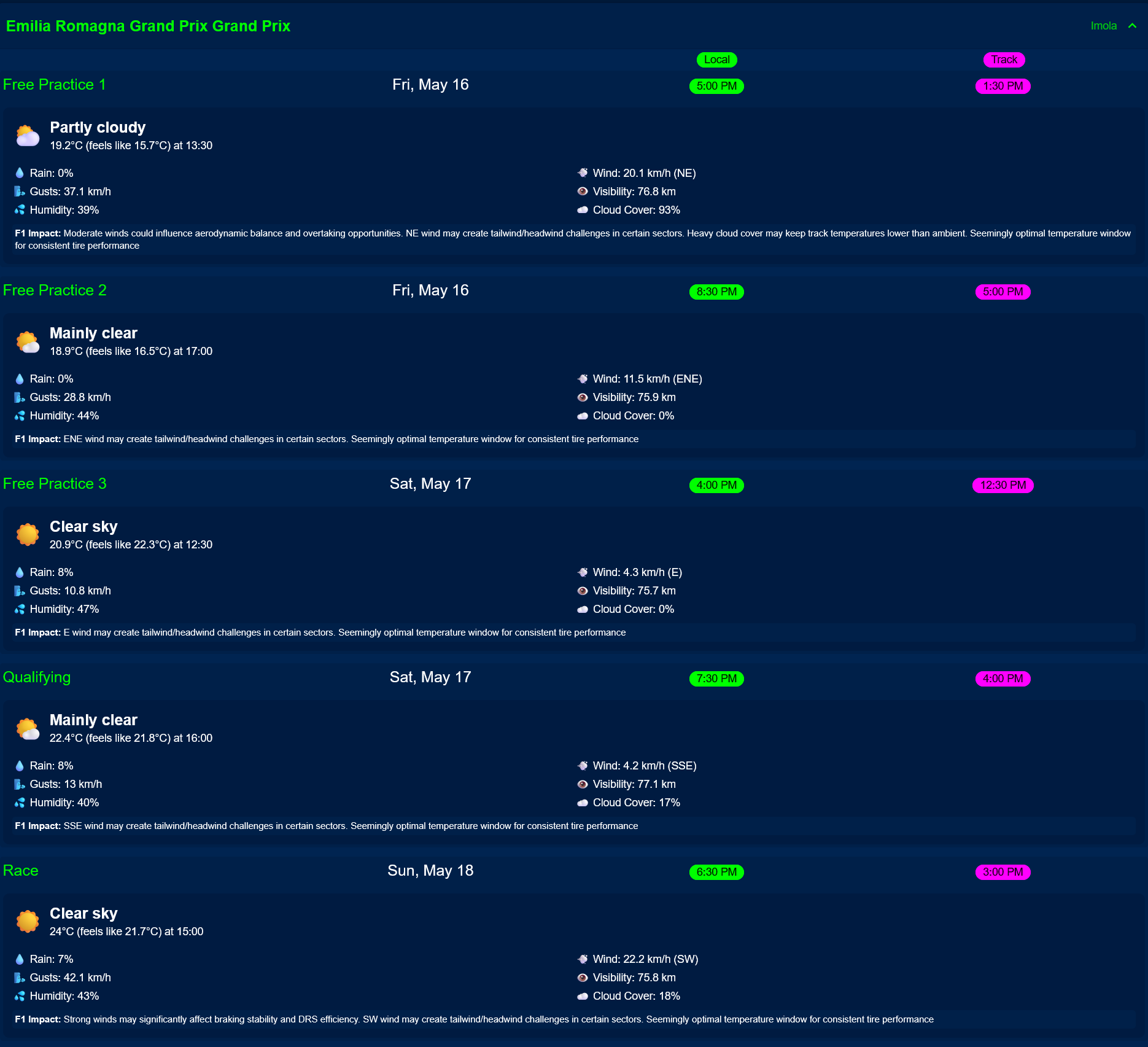
Historical Records and Statistics
-
Most Driver Wins: Michael Schumacher is the king of Imola, having won there seven times. Equal in second place on the list of winners with three apiece are Alain Prost and Ayrton Senna, along with the current world champion Max Verstappen, who has won the last three editions (matching Schumacher's record for three consecutive wins at the track). Fernando Alonso (1 win in 2005 for Renault/Benetton) and Lewis Hamilton are other Imola winners in the current field. Nelson Piquet won the first ever Formula 1 San Marino Grand Prix in 1981.
-
Most Team Wins: Ferrari and Williams have the most wins here with 8 each, ahead of McLaren on 6.
-
Most Driver Poles: Ayrton Senna has the most pole positions with eight, followed by Schumacher on five and René Arnoux on three.
-
Most Team Poles: McLaren has the greatest number of pole positions (8), ahead of Ferrari (6) and Williams (4).
-
Most Driver Podiums: Michael Schumacher tops this list with 12 podium finishes, twice as many as Prost on six, followed by Senna and Gerhard Berger in third place, with five each.
-
Most Team Podiums: Ferrari on 25, McLaren on 22, and Williams on 15.
-
Wins from Grid: 18 of the 31 races held here have been won from the front row. Highlighting how difficult overtaking is, the lowest any winning driver has started is P5.
-
Red Flags in Qualifying: The circuit jointly holds the record for the most red flags in Qualifying, with the session interrupted five times in 2022. The São Paulo Grand Prix tied it in 2024.
-
Historic Drives: Fernando Alonso's victory in 2005 is renowned as one of the best defensive drives, holding off a very committed Michael Schumacher for the final quarter of the race. Alonso is the only current driver to have raced at Imola in its previous incarnation as the San Marino Grand Prix, though Lewis Hamilton took part in GP2 during the 2006 San Marino Grand Prix weekend.
2025 Emilia Romagna Grand Prix – Stat Sheet
Circuit Characteristics
| Characteristic | Value |
|---|---|
| Circuit Length | 4.909 km |
| Race Laps | 63 |
| Race Distance | 309 km |
| Number of Corners | 19 (10 L / 9 R) |
| Distance from Pole to First Braking Zone | 399 m |
| Pole Position Side | Left |
| Pit Lane Length Under Speed Limit Control | 548 m |
| Drive-Through Time at 80 km/h | 25s |
| Lap Time At Full Throttle | 67% |
| Lap Distance At Full Throttle | 74% |
| Gear Changes Per Lap | 52 |
| Braking Events (>2G) | 7 |
| Heavy Braking Events (<0.4s @ >4G) | 2 |
| Braking Energy | Low |
| Maximum Lateral G-Force | 4.6 (T12) |
| Maximum Speed | 328 km/h |
| Fuel Consumption | High |
| DRS Zones | T19–2 |
| Key Overtaking Opportunities | T2 |
2024 Statistics
| Statistic | Value |
|---|---|
| Fastest Lap FP1 | 1:16.990 |
| Fastest Lap FP2 | 1:15.906 |
| Fastest Lap FP3 | 1:15.529 |
| Fastest Lap Q1 | 1:15.762 |
| Fastest Lap Q2 | 1:15.176 |
| Fastest Lap Q3 | 1:14.746 |
| Delta FP1 to Q3 | -2.244s |
| Delta Q1 to Q3 | -1.016s |
| Podium | VER / NOR / LEC |
| Team Result | HAM P6 / RUS P7 |
| Fastest Race Lap | 1:18.589 (RUS) |
| Winning Race Time | 1:25:25.252 |
| Winning Average Speed | 217.077 km/h |
| Qualifying Speed Trap | 300.1 km/h (HUL) |
| Race Speed Trap | 304.6 km/h (MAG) |
| Winning Strategy | 1 Stop (L24) |
| Total Pit Stops | 27 |
| Total Normal Overtakes | 5 |
| Total DRS Overtakes | 25 |
| Race Lap Record | 1:15.484 (HAM, 2020) |
| Absolute Lap Record | 1:13.609 (BOT, Q3, 2020) |
| Not Classified (Accident/DSQ) | 0 |
| Not Classified (Mechanical) | 1 |
Race Characteristics (2020–2024)
| Characteristic | Value |
|---|---|
| Races Featuring Safety Car | 4/5 |
| Total Safety Car Deployments | 5 |
| Safety Car Probability | 80% |
| Safety Car Ratio | 1.0 |
| Wet Sessions | 6/20 |
| Wet Session Probability | 30% |
| Average Track Temperature | 22.8°C |
| Maximum Track Temperature | 29.5°C |
| Average Ambient Temperature | 16.3°C |
| Maximum Ambient Temperature | 19.6°C |
| Ambient Pressure | 1010.9 hPa |
Tyre Allocation
| Compound | Sets Per Driver |
|---|---|
| Soft | 8 |
| Medium | 3 |
| Hard | 2 |
Where to Watch 2025 Miami Grand Prix
I’m constantly changing things up to make this newsletter more useful, so let me know what you think by commenting below. I read every reply! Please do reply. I'm not a robot, I talk back.
Follow me on Whatsapp, Telegram, Facebook, YouTube, LinkedIn, Pixelfed, Tumblr, Bsky, Twitter, Mastodon, Instagram, Sub-Reddit, Threads for more analysis!